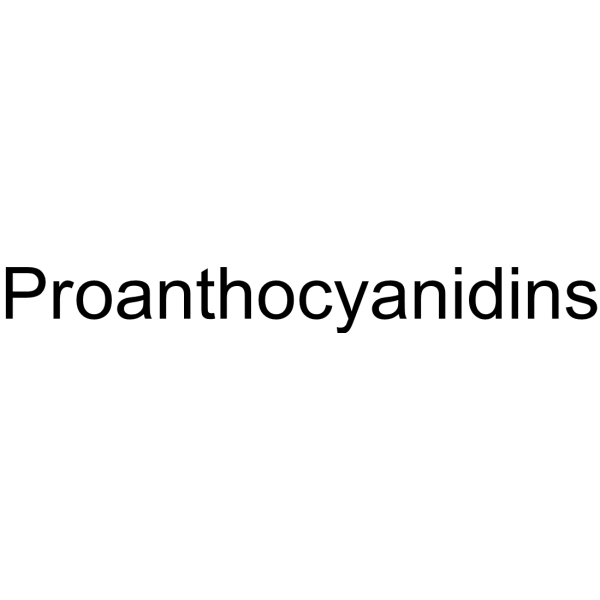Physicochemical Properties
| Molecular Formula | C30H26O13 |
| Molecular Weight | 594.519649982452 |
| Exact Mass | 594.137 |
| CAS # | 20347-71-1 |
| PubChem CID | 107876 |
| Appearance | Light brown to black solid powder |
| Density | 1.9±0.1 g/cm3 |
| Boiling Point | 986.4±65.0 °C at 760 mmHg |
| Flash Point | 550.3±34.3 °C |
| Vapour Pressure | 0.0±0.3 mmHg at 25°C |
| Index of Refraction | 1.876 |
| LogP | 1.46 |
| Hydrogen Bond Donor Count | 10 |
| Hydrogen Bond Acceptor Count | 13 |
| Rotatable Bond Count | 4 |
| Heavy Atom Count | 43 |
| Complexity | 957 |
| Defined Atom Stereocenter Count | 0 |
| InChi Key | HGVVOUNEGQIPMS-UHFFFAOYSA-N |
| InChi Code | InChI=1S/C30H26O13/c31-14-7-19(35)16-11-25(28(41-23(16)9-14)12-1-3-17(33)20(36)5-12)43-30(13-2-4-18(34)21(37)6-13)29(40)27(39)26-22(38)8-15(32)10-24(26)42-30/h1-10,25,27-29,31-40H,11H2 |
| Chemical Name | 2-(3,4-dihydroxyphenyl)-2-[[2-(3,4-dihydroxyphenyl)-5,7-dihydroxy-3,4-dihydro-2H-chromen-3-yl]oxy]-3,4-dihydrochromene-3,4,5,7-tetrol |
| HS Tariff Code | 2934.99.9001 |
| Storage |
Powder-20°C 3 years 4°C 2 years In solvent -80°C 6 months -20°C 1 month |
| Shipping Condition | Room temperature (This product is stable at ambient temperature for a few days during ordinary shipping and time spent in Customs) |
Biological Activity
| ln Vitro | Complex polymer combinations called proanthocyanidins are found in plants. Berries such as cranberries, apples, pears, and red wine, together with tea and chocolate, are the main sources of nutrition[1]. Because proanthocyanidin is found in cranberries (Vaccinium macrocarpon Ait.), it has the most intriguing antibacterial activity. The efficacy of cranberry consumption in avoiding urinary tract infections (UTIs) has been proven by several clinical trials. Escherichia coli is responsible for about 85% of UTIs, despite the fact that numerous other microbes can also cause them. As P-fimbriae are proteinaceous fibers on the bacterial cell wall, they are responsible for attachment to uroepithelial cells, which is why their presence on E. coli has been clearly identified as a virulence factor. According to recent research, cranberry proanthocyanidin may prevent P-fimbriated E. coli from sticking to uroepithelial cells. It seems that proanthocyanidin with at least one A-type linkage is associated with the antiadhesion activity of cranberry juice[1]. |
| ln Vivo | Investigated are the effects of Proanthocyanidin from cacao liquor on 2-amino-1-methyl-6-phenylimidazo [4,5-b] pyridine-induced mutagenesis and in vivo carcinogenesis in female Sprague-Dawley rats. When tested in the presence of the S-9 mixture, proanthocyanidin exhibits potent antimutagenic actions in the Ames test. They also considerably suppress breast carcinogenesis, but not rat pancreatic carcinogenesis in the start stage[1]. |
| References |
[1]. Proanthocyanidins, anthocyanins and cardiovascular diseases. Food research international 2014 v.59 pp. 41-52. [2]. Proanthocyanidins in health care: current and new trends. Curr Med Chem. 2004 May;11(10):1345-59. |
| Additional Infomation |
Procyanidin is oligomeric compounds, formed from catechin and epicatechin molecules. They yield cyanidin when depolymerized under oxidative conditions. Procyanidin has been reported in Lathyrus laxiflorus, Vitis amurensis, and other organisms with data available. |
Solubility Data
| Solubility (In Vitro) |
DMSO : 100 mg/mL H2O : 5 mg/mL |
| Solubility (In Vivo) |
Solubility in Formulation 1: 2.5 mg/mL (Infinity mM) in 10% DMSO + 40% PEG300 + 5% Tween80 + 45% Saline (add these co-solvents sequentially from left to right, and one by one), suspension solution; with sonication. For example, if 1 mL of working solution is to be prepared, you can add 100 μL of 25.0 mg/mL clear DMSO stock solution to 400 μL PEG300 and mix evenly; then add 50 μL Tween-80 to the above solution and mix evenly; then add 450 μL normal saline to adjust the volume to 1 mL. Preparation of saline: Dissolve 0.9 g of sodium chloride in 100 mL ddH₂ O to obtain a clear solution. Solubility in Formulation 2: ≥ 2.5 mg/mL (Infinity mM) (saturation unknown) in 10% DMSO + 90% (20% SBE-β-CD in Saline) (add these co-solvents sequentially from left to right, and one by one), clear solution. For example, if 1 mL of working solution is to be prepared, you can add 100 μL of 25.0 mg/mL clear DMSO stock solution to 900 μL of 20% SBE-β-CD physiological saline solution and mix evenly. Preparation of 20% SBE-β-CD in Saline (4°C,1 week): Dissolve 2 g SBE-β-CD in 10 mL saline to obtain a clear solution. (Please use freshly prepared in vivo formulations for optimal results.) |
| Preparing Stock Solutions | 1 mg | 5 mg | 10 mg | |
| 1 mM | 1.6820 mL | 8.4101 mL | 16.8203 mL | |
| 5 mM | 0.3364 mL | 1.6820 mL | 3.3641 mL | |
| 10 mM | 0.1682 mL | 0.8410 mL | 1.6820 mL |
